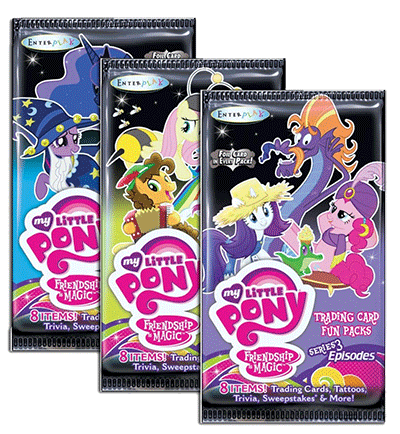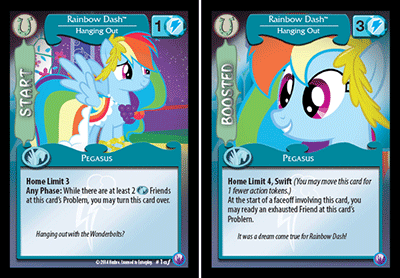My Little Pony CCG Review
on Apr 27, 2016

The My Little Pony CCG, designed by veteran “serious game designer†Darrell Hardy, now includes the original premiere set and six expansions of around 200 cards apiece. A seventh expansion, Marks in Time, releases this spring. Players construct decks from amongst this vast collection consisting of one Mane character, ten problems and 45 other cards – friends, events and resources. All of the cards depict and/or reference characters and stories from Lauren Faust's clever franchise rebranding via the My Little Pony: Friendship is Magic animated show.

The goal is to solve problems as represented by cards from each player’s problem deck. Both will have one out at a time and each stipulates an amount and color of power (often in combination) needed for each player to confront. To meet those power requirements, you can send your Mane character, which always remains in play, and also friends. Resources may be attached to boost your friends’ power and/or alter colors types. Events also aid in reaching needed levels. As soon as you solve a problem, you earn a point (and bonuses if the first to confront it) and continue earning points until your opponent also meets her requirements at that issue. Then a face-off ensues. Both players compare their total value at the problem, add the power from a random card flip and apply any modifiers from cards in play. The winner earns bonus points, the dilemma is solved, every pony goes home and a new problem arises. The first equestrian to fifteen points wins the game.
Those interesting showdowns are further spurred by the design’s limited action point allowance and card play. There is a graded scale of actions available depending on how many points the leader has. So to start a game, each player can only perform two. Options include drawing a card, playing a troublemaker (which makes it more difficult for your opponent to solve a problem), moving a card already in play, readying a frightened character and playing a card from your hand. Some items cost two action points to resolve. Also, when playing a friend from your hand, it often requires that you have a certain amount of a specific color power currently in play. Yet another restriction to plan for is your home’s capacity limit, which depends on your Mane character’s status. To start the game, you may generally only play three friends to your home. That limit increases at some point when your Mane character is leveled up, another of the design’s dynamic features. This restriction rears up as you resolve problems and the problem-solvers hoof it home. You likely will often run out of room.
Despite its head-to-head format, MLP:CCG nicely corrals the theme of friendship and teamwork prominent in Faust’s animated series. Rather than attacking your opponent directly, the focus is on an in-game element – problem cards. And instead of gathering resources or expending something like mana or energy, you employ friends who are assumed to bring their talents to work with you in confronting dilemmas. It’s also a brilliant design feature for simplicity. With currency built into characters as you play them, the title eschews those types of single-purpose resource cards. That translates to thinner decks and quicker action.

Which is nice because MLP:CCG races out at a blistering pace. With only 15 points needed for the win, games are typically fast. So it’s not as deep as other CCG’s. Then again it’s not meant to be. That trait lends itself to avoiding the genre’s principle bane: investment. Sure, you could sell the farm to gobble up booster packs, ad nauseam. But the theme decks provide more than enough to satisfy a sophisticated experience. And since there are plenty of cards in this legitimately strategic design, you can also collect and tweak decks as you desire.
Just as players must confront problems in the game, MLP:CCG faces the dilemma of reaching broader audiences with its sugary content. Faust tackled the same issue in her animated series, creating a show for the whole family about friendship and respect with intelligent characters, relevant and interesting plots and smart geeky references sprinkled throughout. Hardy’s design succeeds in much the same way by giving players and fans real decisions that require planning and investment. Then he deftly ties it all in with the IP’s greater world. Sure, young girls are more likely to buy into the game. But any pony can enjoy it just the same.

 Customer Support
Customer Support  Subscribe
Subscribe 




 Account
Account  Wishlist
Wishlist 
